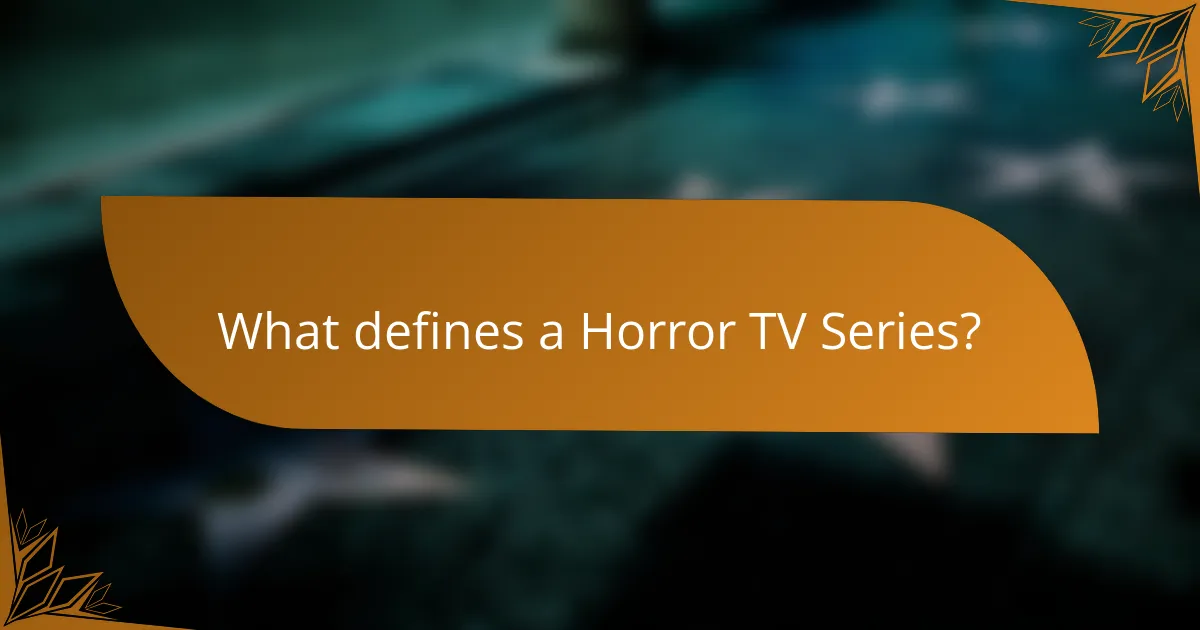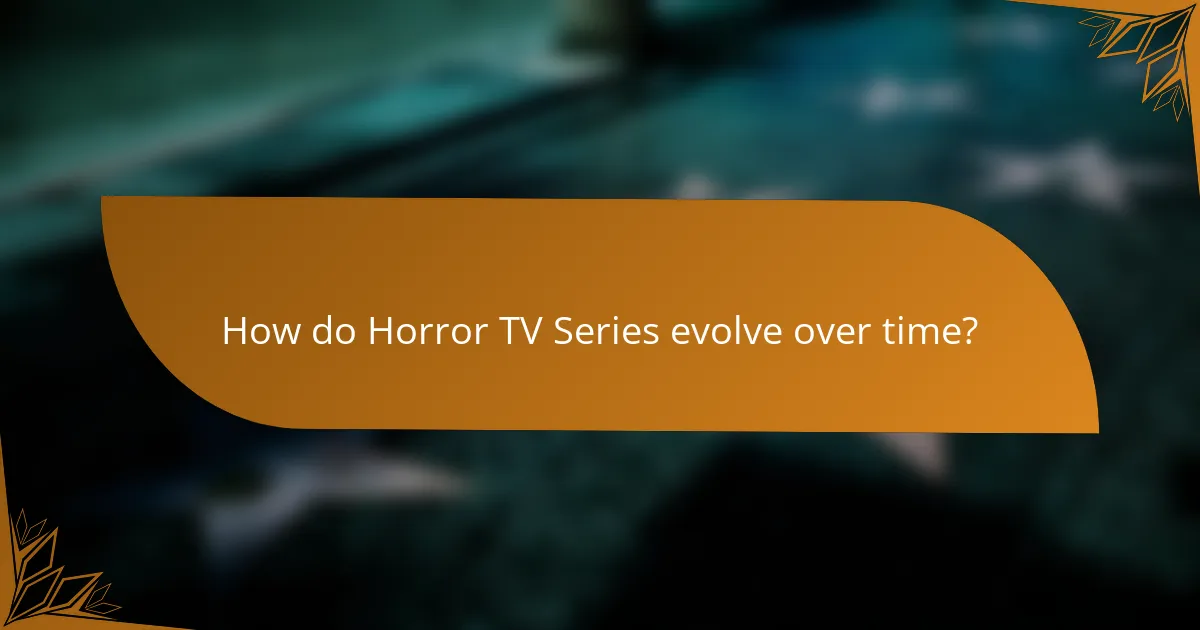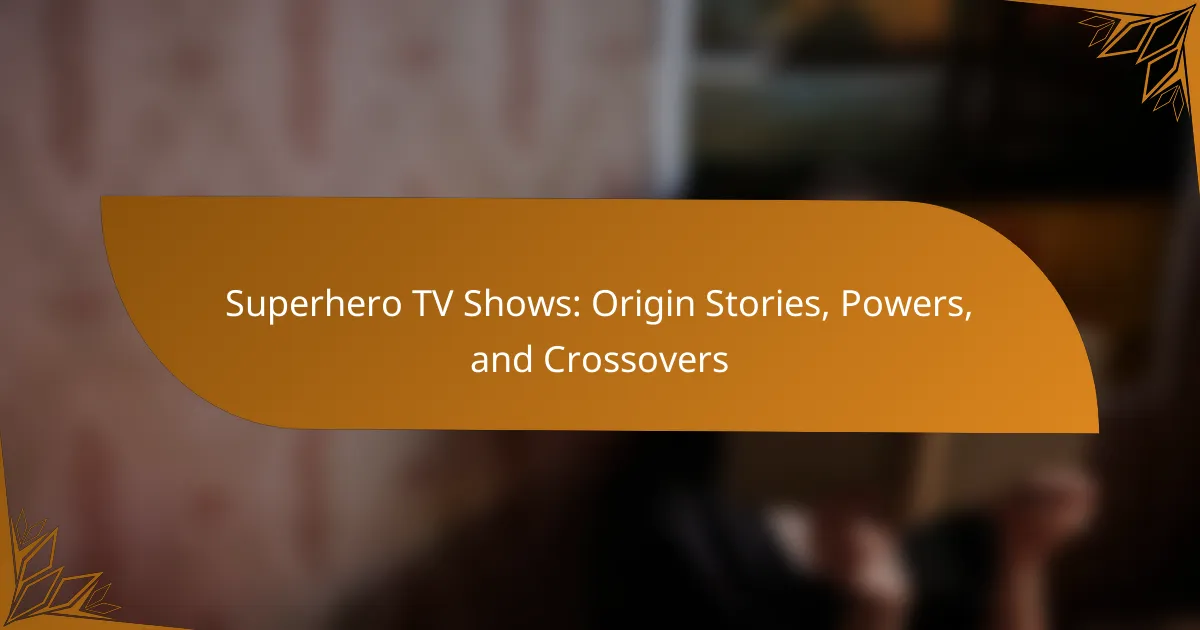Horror TV series are designed to evoke fear and suspense, often incorporating supernatural elements, psychological terror, and disturbing themes. These series utilize dark visuals and unsettling sound design to create a chilling atmosphere, with iconic monsters or villains serving as central figures. The narrative structure frequently includes unexpected twists and cliffhangers, while psychological elements delve into human fears and anxieties. The evolution of the genre reflects changes in cultural trends and audience preferences, with contemporary series like “American Horror Story” and “The Haunting of Hill House” showcasing innovative storytelling and character development. Successful horror series rely on strong narratives, relatable characters, and effective pacing to enhance viewer engagement and retention.

What defines a Horror TV Series?
A Horror TV Series is defined by its intent to evoke fear and suspense in its audience. These series often feature supernatural elements, psychological terror, and disturbing themes. They create a chilling atmosphere through dark visuals and unsettling sound design. Iconic monsters or villains frequently serve as central figures, heightening the tension. The narrative structure often includes unexpected twists and cliffhangers to maintain viewer engagement. Psychological elements explore the depths of fear and human psyche, adding layers to the horror. Examples include series like “American Horror Story” and “The Haunting of Hill House,” which exemplify these characteristics.
How do Horror TV Series create a chilling atmosphere?
Horror TV series create a chilling atmosphere through various techniques. They often utilize suspenseful music to heighten tension. Dark lighting and shadowy settings contribute to an eerie visual experience. Unpredictable plot twists keep viewers on edge. Character development often involves relatable fears, enhancing emotional engagement. The use of jump scares provides sudden shocks that jolt the audience. Themes of isolation and helplessness amplify feelings of dread. Psychological elements, such as exploring the human psyche, deepen the horror experience. Collectively, these techniques effectively immerse viewers in a chilling narrative.
What techniques are used to build suspense in Horror TV Series?
Horror TV series build suspense through techniques like pacing, sound design, and visual cues. Pacing creates tension by controlling the speed of the narrative. Slow reveals of information maintain viewer anticipation. Sound design uses eerie music and sudden noises to evoke fear. Visual cues include dark lighting and unsettling imagery that create an ominous atmosphere. Additionally, cliffhangers at the end of episodes leave viewers eager for more. The use of unreliable narrators can also create doubt and heighten suspense. These techniques are effective in immersing the audience in a state of unease.
How does sound design contribute to the atmosphere?
Sound design significantly contributes to the atmosphere by enhancing emotional engagement. It creates an immersive experience that heightens tension and fear. Specific sound elements, like eerie music and unsettling sound effects, amplify the horror elements. For instance, low-frequency sounds can evoke a sense of dread. Sudden loud noises can trigger shock and surprise. Research shows that sound design influences viewer perception and emotional response. A study published in the Journal of Media Psychology found that sound effects can increase suspense in horror films. Overall, effective sound design is crucial in crafting a chilling atmosphere in horror TV series.
What role do iconic monsters play in Horror TV Series?
Iconic monsters serve as central figures that embody fear in horror TV series. They represent societal anxieties and personal fears. Their presence creates suspense and tension, driving the narrative forward. Monsters often symbolize the unknown, challenging characters’ beliefs and morals. They can also act as catalysts for character development and plot progression. For example, in “Stranger Things,” the Demogorgon represents childhood fears and the loss of innocence. The psychological impact of these monsters enhances viewer engagement and emotional response. Overall, iconic monsters are essential for establishing the chilling atmosphere typical of horror television.
What are the most memorable monsters in Horror TV history?
The most memorable monsters in Horror TV history include characters like Freddy Krueger, Pennywise, and the Demogorgon. Freddy Krueger from “A Nightmare on Elm Street” haunts dreams and embodies fear. Pennywise, from “It,” preys on children’s fears, transforming into their worst nightmares. The Demogorgon from “Stranger Things” represents the unknown and terror from another dimension. Each of these monsters has left a lasting impact on audiences. Their unique traits and terrifying appearances contribute to their memorability. These characters have become icons in the horror genre, influencing countless adaptations and references in popular culture.
How do these monsters reflect societal fears?
Monsters in horror TV series reflect societal fears by embodying the anxieties of their time. They often represent the unknown or the other, symbolizing fears of change and the unfamiliar. For example, vampires can signify fears of disease and mortality, as seen in “The Strain,” which explores viral outbreaks. Similarly, zombies often reflect societal concerns about consumerism and loss of identity, as depicted in “The Walking Dead.” These monsters serve as metaphors for real-world issues, such as political unrest or social isolation. By portraying these fears through monstrous figures, horror series engage viewers in a dialogue about their own societal anxieties. This connection enhances the emotional impact and relevance of the genre.
What psychological elements are prevalent in Horror TV Series?
Horror TV series often incorporate psychological elements such as fear, anxiety, and suspense. These elements create a tense atmosphere that engages viewers. Fear is typically elicited through the portrayal of danger and the unknown. Anxiety arises from uncertainty about characters’ fates. Suspense builds as viewers anticipate frightening events. Additionally, themes of isolation and helplessness are common. These themes resonate with audiences, enhancing emotional responses. Research indicates that horror can trigger a fight-or-flight response, heightening viewer engagement. Studies show that psychological thrills can lead to increased adrenaline and dopamine levels.
How does fear of the unknown affect viewer engagement?
Fear of the unknown significantly increases viewer engagement in horror TV series. This fear creates suspense and anticipation. Viewers are drawn to the unpredictability of the plot. They become more invested in the characters’ fates. A study by the University of California found that suspenseful storytelling enhances emotional responses. This emotional engagement leads to longer viewing times and increased discussions among viewers. Therefore, fear of the unknown serves as a powerful tool in capturing and maintaining audience interest.
What psychological theories are often explored in these series?
Horror TV series often explore psychological theories such as the Uncanny and Terror Management Theory. The Uncanny theory investigates the discomfort arising from familiar yet strange elements. This theory explains why viewers feel unease when faced with monsters that resemble humans. Terror Management Theory examines how fear of death influences behavior and beliefs. It suggests that horror narratives allow viewers to confront their mortality indirectly. Research shows that engaging with horror can lead to increased resilience and coping strategies. These psychological theories provide a framework for understanding the emotional responses elicited by horror series.

How do Horror TV Series evolve over time?
Horror TV series evolve over time by adapting to cultural trends and audience preferences. Initially, early horror series focused on supernatural elements and classic monsters. As television technology advanced, the storytelling became more complex and layered. The introduction of psychological horror added depth to character development. Series like “The Twilight Zone” and “The X-Files” expanded the genre’s narrative possibilities. In recent years, horror series have embraced social commentary and diverse perspectives. Shows like “American Horror Story” and “The Haunting of Hill House” reflect contemporary fears and anxieties. The evolution also includes increased production values and innovative storytelling techniques. Streaming platforms have further transformed the landscape, allowing for serialized storytelling and binge-watching.
What trends have emerged in modern Horror TV Series?
Modern horror TV series have increasingly focused on psychological depth and character-driven narratives. This trend emphasizes the emotional and mental struggles of characters rather than relying solely on traditional horror tropes. Additionally, there is a rise in the use of social commentary within horror. Series often explore themes such as trauma, societal issues, and personal fears.
Another emerging trend is the blending of genres, incorporating elements from fantasy, thriller, and drama. This fusion allows for more creative storytelling and diverse audience engagement. Moreover, streaming platforms have contributed to the trend of serialized storytelling. This format enables deeper exploration of plots and character arcs over multiple episodes.
Finally, a notable trend is the resurgence of classic horror motifs, reimagined for contemporary audiences. This includes iconic monsters and folklore, presented in fresh and innovative ways. These trends reflect a shift towards more nuanced and engaging horror narratives, appealing to a broader demographic.
How has technology influenced the storytelling in Horror TV?
Technology has significantly influenced storytelling in Horror TV by enhancing visual effects and sound design. Advanced CGI allows for more realistic monsters and supernatural elements. This technology creates immersive environments that heighten fear. Additionally, sound design has evolved with surround sound and audio manipulation techniques. These advancements amplify suspense and emotional responses. Streaming platforms enable serialized storytelling, allowing for deeper character development. Data analytics help creators understand audience preferences, tailoring content to maximize engagement. Overall, technology enriches the horror narrative, making it more compelling and impactful.
What themes are becoming more prominent in contemporary series?
Contemporary series are increasingly emphasizing themes of mental health and trauma. These themes explore characters’ psychological struggles and the impact of past experiences. The rise of horror series often incorporates social commentary, addressing issues like systemic oppression and societal fears. Additionally, there’s a notable trend toward complex female characters and their empowerment. This shift reflects a broader cultural movement towards inclusivity and representation. The blending of horror with other genres, such as psychological thriller and drama, is also becoming prominent. These evolving themes resonate with audiences seeking deeper narratives and authentic portrayals.
How do cultural influences shape Horror TV Series?
Cultural influences shape horror TV series by dictating themes, character archetypes, and societal fears. Different cultures bring unique folklore and mythology into storytelling. For instance, Japanese horror often incorporates elements of ghostly spirits, reflecting Shinto beliefs. In contrast, American horror frequently explores themes of isolation and the unknown, resonating with contemporary societal anxieties.
Cultural contexts also impact the portrayal of monsters and villains. The vampire in Western culture often symbolizes seduction and moral decay, while in Eastern cultures, it may represent ancestral spirits or societal taboos. Additionally, horror series often mirror the historical and social issues of their time. For example, the rise of feminist horror in the 2010s reflects growing societal discussions around gender and power dynamics.
The reception of horror series varies across cultures, influenced by local customs and taboos. This leads to distinct adaptations of horror narratives that cater to regional tastes. Overall, cultural influences provide horror TV series with depth, making them relatable and impactful to diverse audiences.
What role does folklore play in the creation of monsters?
Folklore plays a crucial role in the creation of monsters by providing cultural narratives that shape their characteristics. These narratives often reflect societal fears, moral lessons, and historical events. Monsters in folklore are typically symbolic representations of human anxieties. For instance, the Wendigo in Algonquian folklore embodies the fear of starvation and greed. Folklore also serves as a repository of local beliefs and traditions that influence monster design. Many horror TV series draw upon these rich mythologies to create relatable yet terrifying creatures. This connection to folklore enhances the psychological impact of the monsters on audiences. By grounding monsters in familiar cultural contexts, folklore makes them more resonant and frightening.
How do different cultures interpret horror themes?
Different cultures interpret horror themes through their unique beliefs, traditions, and historical contexts. For example, in Western cultures, horror often focuses on the supernatural and psychological fears. This includes themes like ghosts, monsters, and psychological trauma, reflecting societal anxieties. In contrast, Japanese horror frequently emphasizes existential dread and the unknown, often featuring vengeful spirits and folklore. This aligns with cultural beliefs in the afterlife and ancestral spirits. Additionally, Latin American horror often incorporates elements of magical realism, blending everyday life with supernatural occurrences. This reflects cultural narratives and social issues. Each culture’s interpretation is shaped by its values, fears, and storytelling traditions.

What are the best practices for creating a successful Horror TV Series?
Creating a successful horror TV series requires a strong narrative foundation and engaging characters. Start with a compelling premise that captivates the audience. Develop relatable protagonists and well-defined antagonists to enhance emotional investment. Utilize suspenseful pacing to build tension throughout episodes. Incorporate unexpected twists to keep viewers guessing. Establish a chilling atmosphere through effective cinematography and sound design. Use psychological elements to explore deeper fears and anxieties. Historical data shows that series with strong character arcs and innovative storytelling achieve higher viewer retention. For example, shows like “The Haunting of Hill House” received critical acclaim for their character depth and narrative complexity.
What elements should writers focus on when developing a Horror TV Series?
Writers should focus on atmosphere, character development, and plot structure when developing a horror TV series. A chilling atmosphere creates suspense and engages the audience. Effective character development allows viewers to connect emotionally with the characters. Strong plot structure maintains tension and delivers unexpected twists. Additionally, iconic monsters or antagonists can become memorable elements of the series. Psychological elements, such as fear and paranoia, enhance the horror experience. Incorporating these elements can lead to a compelling and successful horror series.
How important is character development in Horror narratives?
Character development is crucial in horror narratives. It enhances emotional engagement with the audience. Well-developed characters evoke empathy, making their fear more relatable. This connection intensifies the horror experience. Studies show that viewers are more affected by stories with complex characters. For example, characters like those in “The Haunting of Hill House” showcase deep backstories. Their personal struggles amplify the narrative’s tension and dread. In contrast, flat characters often lead to predictable and less impactful horror. Therefore, character development significantly shapes the effectiveness of horror storytelling.
What storytelling techniques enhance the horror experience?
Effective storytelling techniques that enhance the horror experience include suspense, foreshadowing, and unreliable narrators. Suspense builds tension by delaying the revelation of key information. This keeps the audience engaged and anxious. Foreshadowing hints at future events, creating anticipation and dread. Unreliable narrators distort reality, making the audience question what is true. These techniques evoke fear and uncertainty, essential elements in horror narratives. Research shows that suspenseful storytelling can increase viewer engagement by up to 50%. Therefore, these techniques are vital for creating a compelling horror experience.
What tips can creators follow to engage their audience effectively?
Creators can engage their audience effectively by utilizing immersive storytelling techniques. Engaging narratives draw viewers into the horror experience. Incorporating relatable characters enhances emotional connection. High-quality visuals and sound design amplify the chilling atmosphere. Regular interaction with the audience fosters community and loyalty. Creators should leverage social media for real-time feedback and discussions. Analyzing audience reactions informs future content decisions. Consistent updates and teasers keep the audience invested and excited. These strategies are supported by successful horror series that maintain viewer interest and build anticipation.
How can creators balance scares with plot development?
Creators can balance scares with plot development by integrating suspenseful moments into the narrative arc. This approach maintains viewer engagement while advancing the storyline. Effective pacing is crucial; creators should alternate between intense scenes and quieter character-driven moments. This technique allows for character development and emotional investment. Foreshadowing can enhance scares while providing context to the plot. Additionally, unexpected twists can surprise audiences, heightening the impact of both scares and plot revelations. Research shows that horror narratives benefit from a blend of emotional depth and tension, resulting in a more immersive experience.
What strategies can be used to maintain suspense throughout a series?
To maintain suspense throughout a series, creators can employ several strategies. First, they can use cliffhangers at the end of episodes. Cliffhangers leave viewers eager to see what happens next. Second, pacing is crucial. Slow reveals of information can heighten tension. Gradually unfolding the plot keeps the audience engaged. Third, strong character development adds depth. Viewers become invested in characters’ fates, increasing suspense. Fourth, misdirection can be effective. Red herrings lead viewers to false conclusions, creating surprise. Fifth, sound design plays a significant role. Eerie soundscapes can evoke fear and anticipation. Lastly, maintaining a consistent tone enhances the overall atmosphere. A cohesive mood keeps viewers immersed in the suspenseful experience. These strategies have been proven effective in various successful horror series.
Horror TV Series are defined by their intent to evoke fear and suspense through supernatural elements, psychological terror, and disturbing themes. This article explores how these series create a chilling atmosphere using techniques such as sound design, pacing, and character development. It examines the role of iconic monsters as embodiments of societal fears and discusses prevalent psychological elements that enhance viewer engagement. Additionally, the article highlights the evolution of horror TV over time, emerging trends, and best practices for creating successful narratives.

